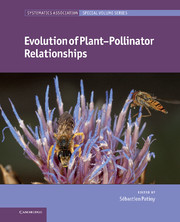Book contents
- Frontmatter
- Contents
- Contributors
- Preface
- 1 Macroevolution for plant reproductive biologists
- 2 Pollination crisis, plant sex systems, and predicting evolutionary trends in attractiveness
- 3 Evolution and ecological implications of “specialized” pollinator rewards
- 4 Fig–fig wasp mutualism: the fall of the strict cospeciation paradigm?
- 5 Fossil bees and their plant associates
- 6 Pollen evidence for the pollination biology of early flowering plants
- 7 Pollinator mediated floral divergence in the absence of pollinator shifts
- 8 Animal pollination and speciation in plants: general mechanisms and examples from the orchids
- 9 Why are floral signals complex? An outline of functional hypotheses
- 10 A survey on pollination modes in cacti and a potential key innovation
- 11 Zygomorphy, area, and the latitudinal biodiversity gradient in angiosperms
- 12 Ambophily and “super generalism” in Ceratonia siliqua (Fabaceae) pollination
- 13 Structure and dynamics of pollination networks: the past, present, and future
- 14 Pollinators as drivers of plant distribution and assemblage into communities
- 15 Effects of alien species on plant–pollinator interactions: how can native plants adapt to changing pollination regimes?
- 16 Pollen resources of non-Apis bees in southern Africa
- 17 Advances in the study of the evolution of plant–pollinator relationships
- Index
- Plate section
- References
7 - Pollinator mediated floral divergence in the absence of pollinator shifts
Published online by Cambridge University Press: 05 January 2012
- Frontmatter
- Contents
- Contributors
- Preface
- 1 Macroevolution for plant reproductive biologists
- 2 Pollination crisis, plant sex systems, and predicting evolutionary trends in attractiveness
- 3 Evolution and ecological implications of “specialized” pollinator rewards
- 4 Fig–fig wasp mutualism: the fall of the strict cospeciation paradigm?
- 5 Fossil bees and their plant associates
- 6 Pollen evidence for the pollination biology of early flowering plants
- 7 Pollinator mediated floral divergence in the absence of pollinator shifts
- 8 Animal pollination and speciation in plants: general mechanisms and examples from the orchids
- 9 Why are floral signals complex? An outline of functional hypotheses
- 10 A survey on pollination modes in cacti and a potential key innovation
- 11 Zygomorphy, area, and the latitudinal biodiversity gradient in angiosperms
- 12 Ambophily and “super generalism” in Ceratonia siliqua (Fabaceae) pollination
- 13 Structure and dynamics of pollination networks: the past, present, and future
- 14 Pollinators as drivers of plant distribution and assemblage into communities
- 15 Effects of alien species on plant–pollinator interactions: how can native plants adapt to changing pollination regimes?
- 16 Pollen resources of non-Apis bees in southern Africa
- 17 Advances in the study of the evolution of plant–pollinator relationships
- Index
- Plate section
- References
Summary
Introduction
The remarkable diversity of the angiosperms is often attributed to their specialized reproductive associations with diverse pollinating vectors (Crepet 1984; Eriksson and Bremer 1992; Grimaldi 1999). The appeal of this argument lies in the premise that specializing on particular pollinating groups can directly result in reproductive isolation from related plant species, even in sympatry, thus generating diversity (Grant 1949; Stebbins 1970). This pollinator shift model is the dominant paradigm explaining floral diversification and is often invoked as an important plant speciation mechanism (reviewed in Kay and Sargent 2009). However, pollinator shifts, which are usually quantitative, not qualitative, often result only in weak reproductive isolation (Armbruster and Muchhala 2009). In addition, sympatric species that use different pollinators are rarely sister species, and most often also exhibit substantial postmating isolation. These observations question the validity of the link between pollinator shifts and reproductive isolation, which underlies the pollinator shift paradigm, and suggest that floral divergence associated with pollinator shifts is unlikely to be a product of selection for reproductive isolation in sympatry, except perhaps upon secondary contact. Instead, floral diversity might result largely from spatially variable influences on efficient gamete transfer (Johnson 2006), a perspective that opens the possibility of numerous mechanisms influencing the divergence of floral traits.
A hallmark of this perspective should be substantial variation in floral traits between closely related allopatrically distributed species, but also between populations of species. Numerous studies document such floral diversity (Herrera et al. 2006; Ellis and Johnson 2009; Schlumpberger et al. 2009), suggesting that geographical variation in floral traits is ubiquitous. Approximately 20 % of British plant species (Warren and Mckenzie 2001), 40 % of the Polemoniaceae (Schemske and Bierzychudek 2007), 38 % of Cape Erica species (Rebelo and Siegfried 1985), and 40 % of Protea species (Carlson and Holsinger 2010) exhibit flower color polymorphisms. Although these numbers confound intra- and interpopulation variation, they do attest to the extent of variation in just a single floral trait.
- Type
- Chapter
- Information
- Evolution of Plant-Pollinator Relationships , pp. 237 - 262Publisher: Cambridge University PressPrint publication year: 2011
References
- 2
- Cited by

